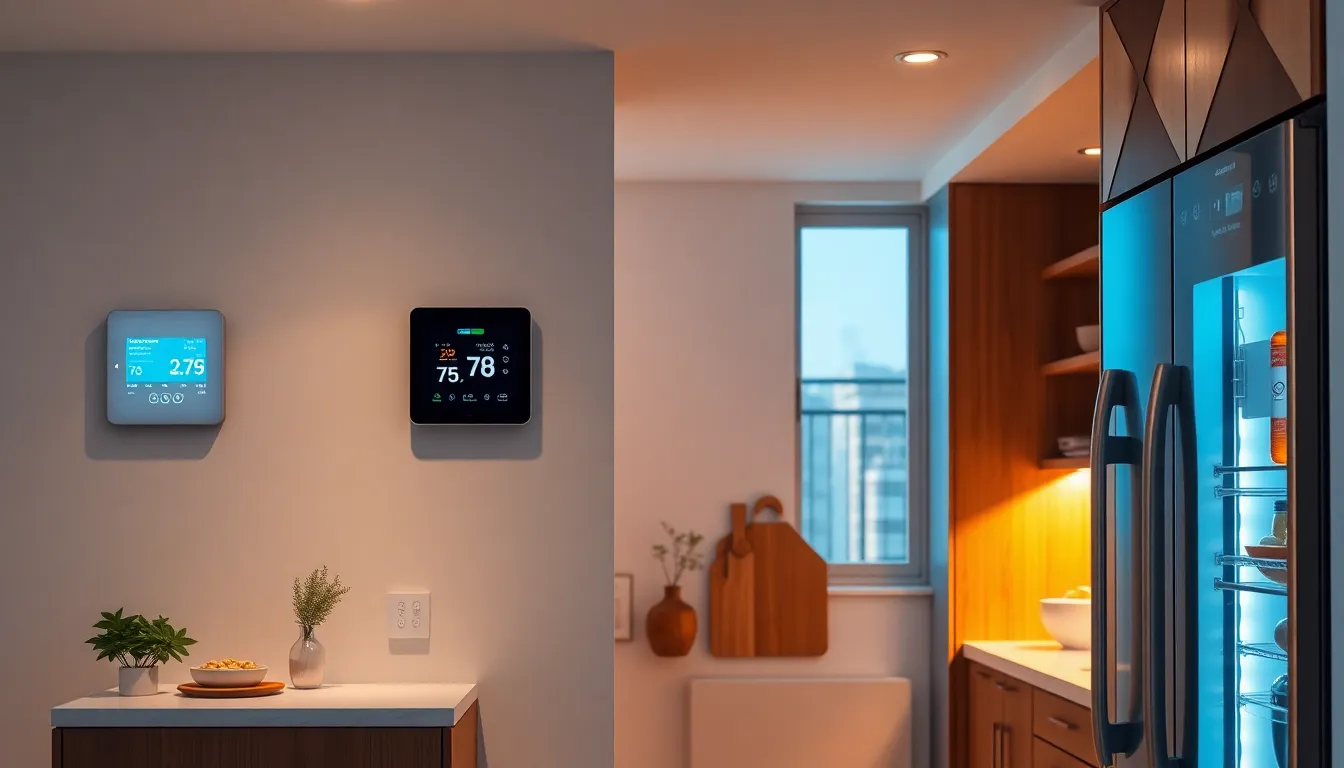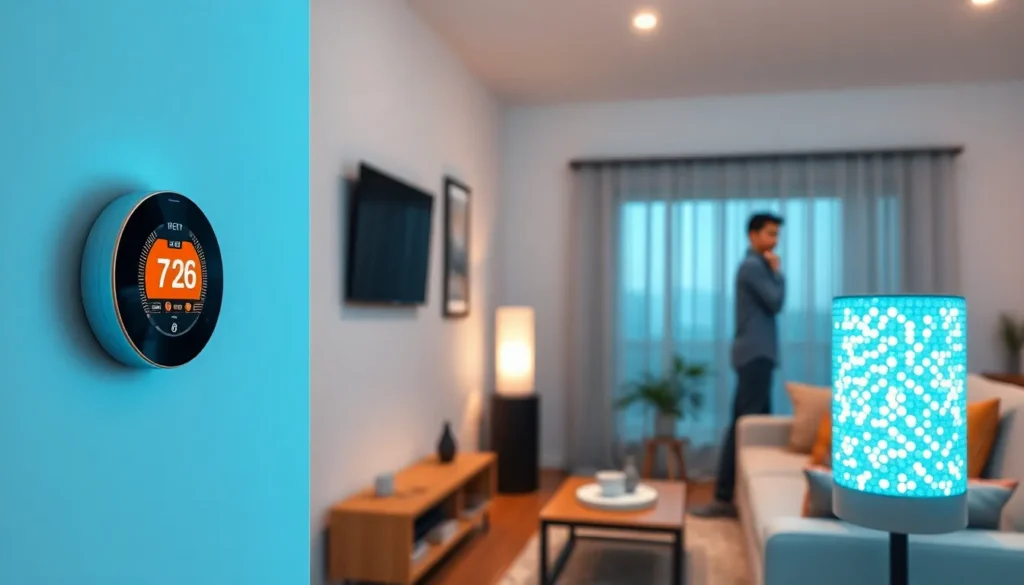Table of Contents
ToggleIn today’s hyper-connected world, IoT devices are transforming how people interact with technology. From smart home gadgets to industrial sensors, these devices create a seamless network that enhances convenience and efficiency. As they become increasingly integrated into daily life, understanding their impact is crucial for both consumers and businesses.
The Internet of Things isn’t just a buzzword; it’s a revolutionary shift that’s reshaping industries and personal experiences alike. With the ability to collect and analyze data in real-time, IoT devices offer unparalleled insights and automation. As this technology continues to evolve, it opens doors to new possibilities, making life smarter and more efficient.
Overview of IoT Devices
IoT devices represent a diverse range of interconnected devices that communicate via the Internet. These devices encompass smart home products, wearable technology, and industrial sensors. Each device connects, collects, and exchanges data, enabling users to enhance their daily activities and streamline operations.
Types of IoT Devices
- Smart Home Devices: Smart thermostats, security cameras, and lights facilitate automated control, improving convenience.
- Wearable Devices: Fitness trackers, smartwatches, and health monitors gather personal health data, offering insights into physical well-being.
- Industrial IoT Devices: Sensors, actuators, and machinery in manufacturing improve efficiency and safety through real-time monitoring.
Applications of IoT Devices
- Smart Homes: Automation provides energy management, security monitoring, and convenience through connected appliances.
- Healthcare: Remote monitoring devices enable healthcare providers to track patient health metrics, improving outcomes.
- Agriculture: Precision farming devices optimize resource use and crop management through real-time data.
Benefits of IoT Devices
- Enhanced Efficiency: Automation reduces manual effort, allowing for optimized processes across various applications.
- Data-Driven Insights: Real-time data collection aids in informed decision-making and predictive analysis.
- Improved Quality of Life: Increased convenience in daily tasks and better management of resources leads to a higher quality of life.
Challenges of IoT Devices
- Security Risks: Increased connectivity raises concerns about data privacy and unauthorized access.
- Interoperability Issues: Diverse standards among devices can hinder seamless integration and operation.
- Scalability: Expanding IoT networks may introduce complications in management and maintenance.
Types of IoT Devices


IoT devices fall into two primary categories, each serving distinct purposes and applications. Understanding these types aids in grasping their functionalities and impact.
Consumer IoT Devices
Consumer IoT devices enhance daily living by improving comfort, security, and efficiency. Examples include:
- Smart Home Devices: These include smart thermostats, lighting systems, and security cameras that provide remote monitoring and automation capabilities. For instance, smart thermostats adapt to user behavior, optimizing energy consumption.
- Wearable Devices: Fitness trackers and smartwatches fall under this category. They monitor health metrics and provide notifications, promoting well-being and active lifestyles.
- Smart Appliances: Devices such as smart refrigerators and voice-activated assistants improve daily tasks through automation and connectivity. Smart refrigerators can track food inventory and provide recipe suggestions based on available ingredients.
Industrial IoT Devices
Industrial IoT devices focus on optimizing processes and enhancing operational efficiency within manufacturing and other industries. Key examples include:
- Sensors: Temperature, pressure, and humidity sensors monitor environmental conditions, enabling real-time data collection that supports predictive maintenance.
- Connected Machinery: Equipment equipped with IoT capabilities allows for remote monitoring and diagnostics. This facilitates improved maintenance and minimizes downtime.
- Fleet Management Tools: These devices track vehicle location, fuel consumption, and driver behavior. They improve logistics efficiency and contribute to cost reduction.
By categorizing IoT devices, one can better appreciate their contributions to various sectors and daily life, driving efficiency and enhancing experiences.
Benefits of IoT Devices
IoT devices offer numerous advantages that significantly impact daily life and business operations. Enhanced efficiency and improved connectivity are among the most notable benefits.
Improved Efficiency
IoT devices automate routine tasks, reducing manual effort and time. Automation streamlines processes, leading to faster operations in both home and industrial settings. For instance, smart thermostats adjust temperatures autonomously based on user preferences, optimizing energy consumption and lowering utility bills. Industrial IoT sensors monitor equipment conditions and predict maintenance needs, decreasing downtime and extending asset lifecycles. Additionally, real-time data analytics enable businesses to refine operations, making informed decisions that boost overall productivity.
Enhanced Connectivity
IoT devices create a seamless network that connects various devices and systems. Enhanced connectivity facilitates communication between household gadgets, wearable technology, and industrial machines. Smart home systems allow users to control lighting, security, and appliances remotely, increasing convenience and ensuring safety. In industries, interconnected machinery enables remote monitoring and diagnostics, improving response times and operational agility. The integration of diverse devices fosters collaboration and data sharing, promoting a more interconnected environment across sectors and enhancing user experiences.
Challenges Faced by IoT Devices
IoT devices encounter several challenges that can hinder their performance and acceptance. Understanding these challenges is crucial for ensuring effective deployment and usage.
Security Concerns
Security risks pose significant challenges for IoT devices. Many devices lack adequate security measures, making them vulnerable to cyberattacks. Hackers can exploit weak passwords, outdated firmware, or unsecured connections. In 2020, approximately 60% of organizations reported a breach involving IoT devices, highlighting the urgent need for stronger security protocols. Implementing encryption, multi-factor authentication, and regular software updates can mitigate these risks. Device manufacturers should prioritize security during the design phase, incorporating robust features to protect users and their data.
Data Privacy Issues
Data privacy issues arise from the extensive data collection associated with IoT devices. These devices often gather sensitive information, such as location, health metrics, and personal preferences. In 2023, over 50% of consumers expressed concerns about how their data is used and shared. Without proper safeguards, this data can be accessed or misused by unauthorized parties. Strict data governance policies and transparent user agreements can address these concerns. Manufacturers must ensure compliance with regulations, such as the GDPR, to protect user privacy and build trust with consumers.
Future of IoT Devices
The future of IoT devices promises substantial advancements in technology, connectivity, and applications. Trends indicate that the proliferation of 5G technology will significantly enhance the performance and capabilities of IoT devices. With faster data transmission and reduced latency, 5G facilitates real-time communication, enabling devices to operate more efficiently and respond promptly to user inputs.
Innovations in artificial intelligence (AI) and machine learning (ML) complement IoT growth by providing smarter analytics and automation. Devices capable of learning from user behavior will offer personalized experiences, adapting to individual preferences. For instance, smart home systems can anticipate energy usage patterns and adjust settings automatically, optimizing comfort and efficiency.
Integration with edge computing is another noteworthy advancement. By processing data closer to the source, edge computing reduces the load on centralized servers and enhances data processing speeds. This integration is essential for applications requiring immediate feedback, such as autonomous vehicles and industrial automation.
Sustainability will also play a vital role in the future of IoT devices. As environmental concerns escalate, IoT solutions that monitor and optimize resource consumption will gain traction. Smart agriculture applications, for example, can minimize water usage and maximize crop yields by analyzing soil conditions and weather patterns.
Market projections indicate significant growth in IoT adoption across various sectors. According to Statista, the global number of IoT-connected devices is expected to reach 30.9 billion by 2025. Industries such as healthcare and manufacturing will increasingly leverage IoT technologies to enhance operational efficiencies and patient care.
Investments in security measures will become paramount as IoT devices proliferate. Addressing the vulnerabilities inherent in interconnected devices is crucial. Future developments will likely prioritize advanced encryption methods and robust authentication processes to safeguard user data from breaches.
Ultimately, the evolution of IoT devices hinges on innovation and adaptability across various sectors, paving the way for smarter living and improved operational efficiencies.
The rise of IoT devices is reshaping how individuals and businesses interact with technology. With the potential for smarter living and enhanced operational efficiency these devices are becoming indispensable. As they continue to evolve the importance of security and data privacy cannot be overstated.
Investing in robust security measures is essential to safeguard user information and maintain trust. Looking ahead advancements in connectivity and intelligence will further amplify the benefits of IoT. As the landscape evolves staying informed and proactive will ensure users can fully leverage the advantages while mitigating risks.
Embracing this technology offers a pathway to a more connected and efficient future.





